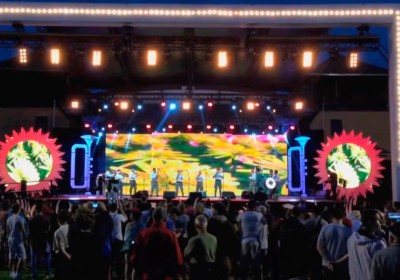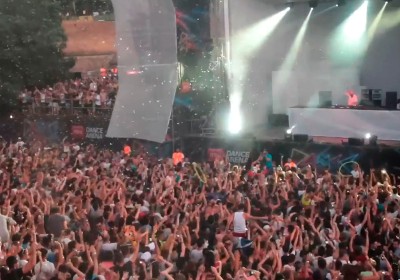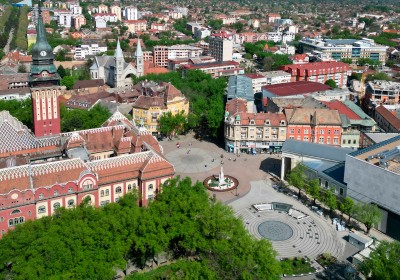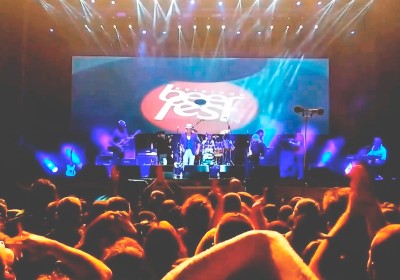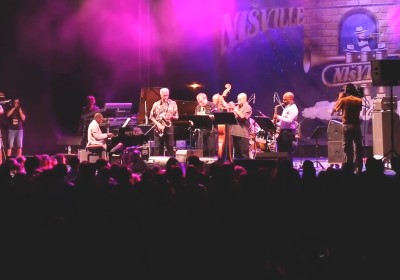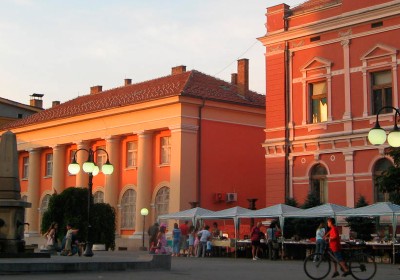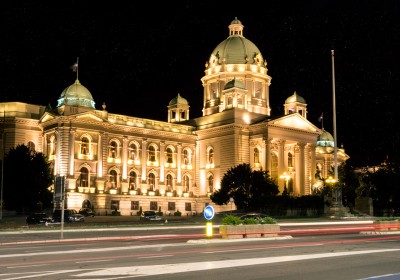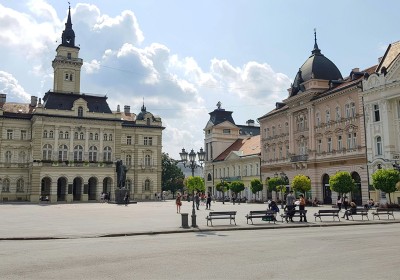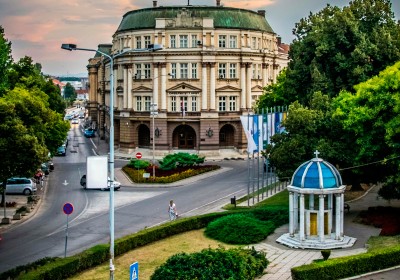Art and History: The Dual Charms of Kovačica and Vršac
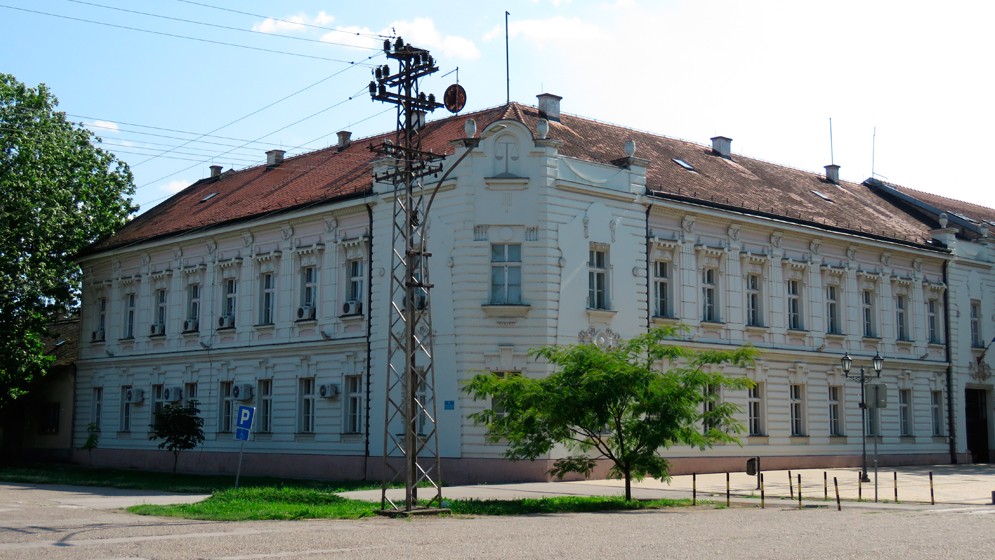
1. Municipal Court in the town of Kovačica
Nestled in the heart of Serbia’s Vojvodina region, the charming towns of Kovačica and Vršac offer visitors a unique glimpse into the rich cultural tapestry of northern Serbia. These two destinations, each with its own distinct character, provide an enticing blend of art, history, and natural beauty that beckons travelers to venture beyond the well-trodden tourist paths.
Together, Kovačica and Vršac represent two facets of Vojvodina’s charm – one celebrated for its folk art and rural traditions, the other for its historical significance and viticultural heritage. This article will guide you through the must-see attractions and hidden gems of these two remarkable Serbian towns, inviting you to discover the authentic experiences they offer to curious and discerning travelers.
Kovačica
Kovačica is a charming town nestled in the South Banat District of Vojvodina. Located just 43km from Belgrade and 27km from Pančevo, this small town of about 5,400 residents serves as the center of a larger municipality of over 21,000 people. Its proximity to the capital makes it an ideal day trip destination for those looking to experience the unique cultural tapestry of rural Serbia.
The town’s history dates back to the 18th century when it was first settled by Serb soldiers in 1751-1752. However, Kovačica’s cultural identity took a significant turn in 1783 when Slovak settlers began arriving, bringing with them traditions and artistic styles that would come to define the town. Today, Kovačica stands as a testament to Serbia’s rich multicultural heritage, with Slovaks making up the largest ethnic group (about 41% of the municipality’s population), followed by Serbs, Hungarians, and Romanians.
Kovačica’s claim to fame lies in its remarkable tradition of naive art, which has put this small town on the global cultural map. Since the mid-20th century, local artists have been creating vibrant, colorful paintings that depict rural life, traditions, and folklore. This artistic movement has not only preserved local customs and memories but has also become a significant draw for art enthusiasts from around the world.
The town’s economy, while modest, reflects its rural character and artistic bent. Agriculture plays a significant role, with the municipality boasting 54,000 hectares of fertile land. However, it’s the town’s cultural output – particularly its naive art – that has become its most famous export. The local Gallery of Naive Art, founded in 1955, stands as a testament to Kovačica’s commitment to preserving and promoting this unique artistic tradition.
Visitors to Kovačica will find themselves immersed in a world where art, tradition, and rural charm intersect. The town’s streets, lined with traditional houses and workshops of local artists, offer a glimpse into a way of life that has remained largely unchanged for generations. Whether you’re an art lover, a cultural enthusiast, or simply a curious traveler, Kovačica offers a uniquely authentic experience of Serbian rural life and folk art traditions.
Key Attractions in Kovačica
Kovačica is renowned for its rich cultural heritage, particularly its naive art tradition and historical significance. Here are five must-visit attractions that showcase the town’s unique charm and artistic legacy.
1. Gallery of Naive Art (Galerija naivne umetnosti)
Founded in 1955, this gallery is the heart of Kovačica’s naive art scene. It houses an impressive collection of paintings, showcasing the work of renowned local artists. The gallery organizes various cultural events, with the highlight being the traditional “Kovačički Oktobar” exhibition. Visitors can admire works by notable artists such as Martin Jonaš and Zuzana Halupova. The gallery offers an immersive experience into the world of naive art and is open daily to visitors.
2. Martin Jonaš Memorial House (Spomen kuća Martina Jonaša)
Dedicated to one of Kovačica’s most famous naive artists, this memorial house offers a glimpse into Martin Jonaš’s life and work. Jonaš’s paintings are known for their depiction of rural life, with characteristic oversized hands and feet on his figures. The house contains a significant collection of his paintings, along with works by other artists he collected, books, hand-painted plates, furniture, and traditional Slovak attire. Visitors should note that a visit to the memorial house needs to be arranged in advance.
3. Jan Nemček’s Violin Workshop
Jan Nemček, a renowned violin maker, welcomes visitors to his workshop in Kovačica. Here, tourists can observe the intricate process of handcrafting violins and gain insight into this traditional craft. Nemček, who studied under master luthiers and even opened a violin-making school in Slovakia, offers a unique opportunity to see a master craftsman at work.
4. Babka Gallery (Galerija Babka)
Established in 1991, the Babka Gallery focuses on promoting young Kovačica artists and other local art forms. In 2001, UNESCO recognized it as a world center for publishing about naive art. The gallery operates on the principle of “Living Human Treasure”, providing free generational transfer of knowledge and skills in creating art objects and souvenirs. It’s an excellent place to discover emerging talents and purchase unique artworks.
5. The Mihajlo Pupin Memorial Complex in Idvor
Located in the nearby village of Idvor, this complex honors Mihajlo Pupin, a famous Serbian-American scientist and inventor. The complex includes Pupin’s birth house, a museum collection housed in the old school building, and the People’s Home. Visitors can explore exhibits showcasing Pupin’s most significant inventions and learn about his life and contributions to science. The complex provides insight into the life of one of Serbia’s most prominent historical figures and his impact on global scientific advancement.
Other Information for Travelers
Kovačica offers a unique culinary experience that reflects its multicultural heritage. Visitors can sample traditional Serbian delicacies, with a special mention of the poppy strudel, a local favorite. Many restaurants and cafes in the town serve authentic dishes that showcase the flavors of the region. Don’t miss the opportunity to taste some of the fine wines produced in the nearby vineyards, which have been cultivated in this area since ancient times.
The town comes alive during various cultural events throughout the year. One of the most significant is the “Kovačički oktobar” (Kovačica October), an annual art exhibition that showcases the latest works of local naive artists. This event attracts art enthusiasts from around the world and provides a perfect opportunity to immerse yourself in the town’s vibrant artistic atmosphere.
For those interested in the broader cultural landscape, Kovačica is home to several cultural institutions beyond its art galleries. The town has a rich theatrical tradition, with performances often held at the local cultural center. Additionally, there are several churches representing different denominations, reflecting the town’s diverse religious heritage. These include Serbian Orthodox, Roman Catholic, and Protestant churches, each with its own unique architectural style and historical significance.
Nature lovers will appreciate the town’s proximity to beautiful rural landscapes. The surrounding area offers opportunities for light hiking, cycling, and birdwatching. The nearby Tamiš River provides a scenic backdrop for outdoor activities and is a popular spot for fishing enthusiasts.
Lastly, visitors should be aware that Kovačica, like many small towns in Serbia, has a relaxed, slower pace of life. While this adds to its charm, it also means that some services may have limited hours, especially on weekends. It’s advisable to check opening times in advance, particularly for smaller establishments and attractions. The locals are known for their hospitality, and many speak Slovak in addition to Serbian, reflecting the town’s unique cultural blend.
Vršac
Vršac is located near the Romanian border, approximately 85 kilometers northeast of Belgrade. The town’s strategic position at the foot of the Vršac Mountains and on the edge of the Pannonian Plain has shaped its development and character over the centuries.
The history of Vršac stretches back to ancient times, with evidence of human settlement dating from the Neolithic period. Throughout its long history, the area has been inhabited by various cultures and peoples, including Dacians, Romans, Slavs, and Hungarians, each leaving their mark on the town’s rich cultural tapestry. The name “Vršac” first appeared in written records in 1427, although the settlement itself is much older.
Today, Vršac is a multicultural town with a population of around 36,000 in its urban area. The city prides itself on its diversity, with significant Serbian, Romanian, and Hungarian communities living side by side. This cultural mix is reflected in the town’s architecture, cuisine, and local traditions, making Vršac a fascinating destination for those interested in the region’s complex history and heritage.
Vršac’s economy is diverse, with a strong focus on agriculture, particularly viticulture. The surrounding area is renowned for its vineyards, which have been cultivated since ancient times. The town is also an important industrial center, with pharmaceuticals being a key sector. This blend of traditional agriculture and modern industry gives Vršac a unique economic character.
For travelers, Vršac is easily accessible by both road and rail. The international railway connecting Vienna, Budapest, Belgrade, and Bucharest passes through the town, making it a convenient stop for those exploring the region. Additionally, Vršac boasts a small airport primarily used for pilot training, adding to its transportation options. The town’s proximity to the Serbian-Romanian border (just 14 km away) also makes it an excellent base for those interested in cross-border exploration.
Key Attractions in Vršac
Vršac boasts a rich tapestry of historical, cultural, and architectural landmarks that reflect its long and diverse history. Here are five must-visit attractions that showcase the town’s unique heritage and charm.
1. Vršac Castle (The Tower of Vršac)
Perched atop a 399-meter hill, the Vršac Castle is the town’s most iconic landmark. This magnificent edifice, likely built in 1439 by orders of Despot Đurađ Branković, offers panoramic views of the surrounding area. The preserved defensive tower stands 19.85 meters tall, with sides 13.8 and 11 meters wide. Despite partial destruction following the 1701 Treaty of Karlovac, the castle remains a testament to medieval Serbian architecture and a symbol of Vršac’s enduring spirit.
2. The Synod Church
Built in 1785 during Bishop Nikola Dimitrijević’s tenure, the Synod Church is one of the oldest Orthodox church in Vršac. Its interior is a treasure trove of Serbian art, featuring works by renowned painters. The iconostasis, painted by Pavel Đurković, and wood carvings by Aksentije Marković are particularly noteworthy. The church also houses two valuable paintings by the famous artist Paja Jovanović: “St. Nicolas Saving the Condemned” and “St. Angelina.”
3. Mesić Monastery
Located near Vršac, the Mesić Monastery dates back to the 15th century and is believed to have been founded by the Branković family. The monastery church, built in the traditional Raška style, features elements of the Morava architectural school. Its walls are adorned with three layers of frescoes created between the 16th and 19th centuries. The monastery is also known for its miraculous icon of the Mother of God, brought from Mount Athos in 1803.
4. The Town Hall
Vršac’s Town Hall, an architectural gem, was built in 1859 in the neo-gothic style. The construction began at the proposal of Town Head Aleksandar Stojaković. A fascinating detail is that a memorial, written in Latin and Serbian and signed by all prominent townsmen, was built into its foundation. The Town Hall stands as a symbol of Vršac’s civic pride and historical continuity.
5. The Pharmacy on Stairs (Town Museum)
Housed in an 18th-century building, the Pharmacy on Stairs is part of the Town Museum complex. It was Vršac’s first pharmacy, opened in 1784. Today, it showcases a well-preserved collection of pharmaceutical equipment, offering visitors a glimpse into the history of medicine and pharmacy. The museum also features a unique collection of stuffed animals from the late 19th and early 20th centuries, adding an intriguing dimension to its historical exhibits.
Other Information for Travelers
Vršac is renowned for its winemaking tradition, which dates back to ancient times. The area around Vršac is ideal for vine-growing, with a history stretching from the Dacian and Roman periods. In 1494, a barrel of Vršac wine was valued at ten and a half gold coins by the treasurer of Hungarian King Laszlo II, attesting to its quality. Today, visitors can explore the vineyards and enjoy wine tasting experiences, particularly during the “Vintage Days” festival held annually in September. This event, known locally as “Grožđebal” (Grape Ball), offers a perfect opportunity to sample local wines and participate in various cultural and sporting events.
For those interested in recreation and sports, Vršac offers several options. The Millennium Sport Centre, opened in 2001, is a modern complex that includes a sports hall, fitness facilities, and a congress hall. It’s suitable for various sporting activities and can host cultural events as well. Nature enthusiasts will appreciate the town’s proximity to the Vršac Mountains, which provide opportunities for hiking and enjoying panoramic views of the surrounding landscape.
Vršac’s multicultural character is reflected in its religious diversity. In addition to the Serbian Orthodox churches, visitors can explore the Roman Catholic Cathedral of St. Gerhard, built in 1863 in the Neogothic style. The town also boasts a Romanian Orthodox Cathedral, completed in 1912, showcasing the architectural and cultural influences of the region’s Romanian community.
For those interested in literature and theatre, Vršac has a rich cultural scene. The town is the birthplace of Jovan Sterija Popović, a famous Serbian playwright, and hosts a traditional festival of classical theatre plays called “Vršac Theatrical Autumn.” The National Theatre “Sterija,” established in 1945, continues this theatrical tradition. Literature enthusiasts can visit the Town Library, one of the oldest in the country, founded in 1887 and housing a collection of over 200,000 books.
Visitors should also take time to explore the Town Park, one of the oldest parks in Serbia. Declared a Natural Monument in 2000, it covers nearly 6 hectares and features a mix of French and English landscaping styles. The park, along with the modern pedestrian zone in the town center, provides pleasant spaces for relaxation and leisurely strolls. These areas, complete with fountains, old oak trees, and cafes, offer a glimpse into the everyday life of Vršac and are perfect for people-watching or enjoying a coffee break between sightseeing adventures.
Conclusion
As we conclude our journey through Kovačica and Vršac, it becomes clear that these two towns, though distinct in character, together offer a compelling glimpse into the diverse tapestry of Vojvodina. Their proximity to each other, coupled with their contrasting attributes, makes them ideal companions for a rich and varied Serbian travel experience.
The artistic spirit of Kovačica and the historical depth of Vršac complement each other beautifully, providing travelers with a balanced blend of cultural immersion. From the colorful canvases of naive artists to the ancient stones of medieval fortresses, visitors can traverse centuries of tradition and creativity within a short distance.
Moreover, these towns serve as gateways to understanding the multicultural heritage of Vojvodina. The Slovak influence in Kovačica and the Serbian, Romanian, and Hungarian elements in Vršac showcase the region’s cultural diversity, offering insights into the complex history and harmonious coexistence of various ethnic groups in this part of Serbia.
For the discerning traveler, a visit to both Kovačica and Vršac provides a unique opportunity to experience the essence of Vojvodina – its artistic flair, historical richness, natural beauty, and warm hospitality. Together, Kovačica and Vršac present an illuminating tapestry of northern Serbia’s treasures, promising a journey that deepens one’s appreciation for this unique corner of Europe.
- Mickey Mystique, CC BY-SA 4.0, via Wikimedia Commons
